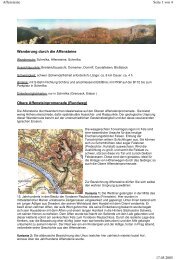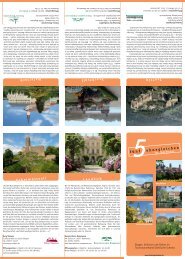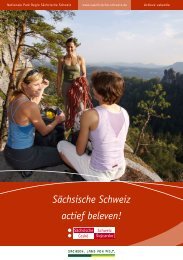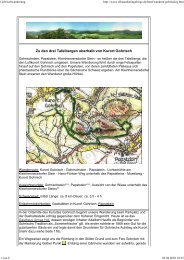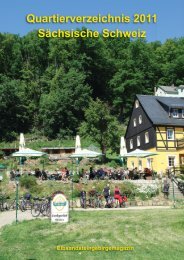Saxon Switzerland Active experience - Tourismusverband ...
Saxon Switzerland Active experience - Tourismusverband ...
Saxon Switzerland Active experience - Tourismusverband ...
You also want an ePaper? Increase the reach of your titles
YUMPU automatically turns print PDFs into web optimized ePapers that Google loves.
Little wonder that elite climbers refer to<br />
“their” <strong>Saxon</strong> <strong>Switzerland</strong> as the centre of<br />
the "Old World": this is the true home<br />
of the sport. In 1874, stonemason Otto<br />
Ewald Ufer and his companion H. Frick<br />
managed to reach the summit of the<br />
Mönchstein near Rathen using only ladders<br />
and iron clamps. In their wake, the<br />
rock was conquered by Oscar Schuster and<br />
later by Rudolf Fehrmann. And so <strong>Saxon</strong><br />
<strong>Switzerland</strong> became the birthplace of free<br />
climbing. From the first climbing shoes<br />
with hemp soles and summit registers to<br />
the first difficulty scale, of I to III, and<br />
climbing regulations, the framework for<br />
the sport of climbing was made in <strong>Saxon</strong><br />
<strong>Switzerland</strong>.<br />
Today, more than 1,100 climbing rocks,<br />
with approximately 18,000 routes, are<br />
available to free climbers of all levels and<br />
against the breathtaking backdrop of the<br />
Elbe Sandstone Mountains. Opportunities<br />
to ascend and descend are endless in what<br />
is a theatre of dreams for climbers who seek<br />
a unique <strong>experience</strong> in a precious natural<br />
environment. Names such as “Lokomotive”<br />
(locomotive), “Talwächter” (keeper of<br />
the valley) or “Wehlnadel” (the needle)<br />
describe well nature’s works of art.<br />
Climbing<br />
“The Elbe Sandstone Mountains are the Earth's<br />
most beautiful climbing region” Climbing pioneer Jean Claude Droyer<br />
www.saechsische-schweiz.de<br />
Safely up the wall<br />
With few limitations (some areas have<br />
been afforded special conservation status)<br />
elite climbers come from all corners of<br />
the globe to find freestanding sandstone<br />
rocks and climbing trails of all degrees of<br />
difficulty, from I to XII.<br />
Community path at the Wilde Zinne, 1938; first<br />
ascent 8a<br />
13




